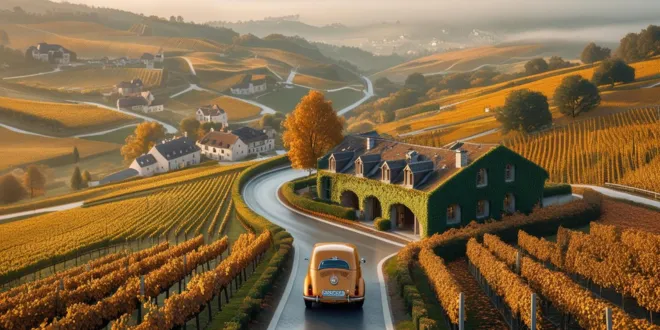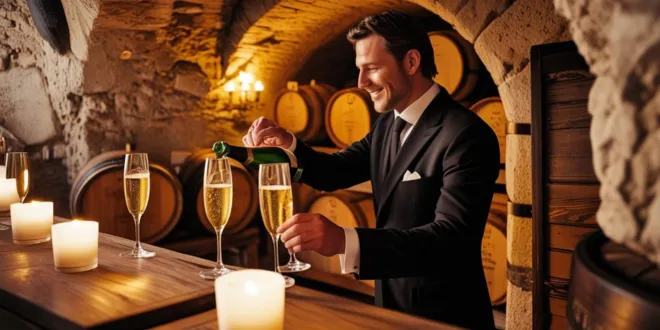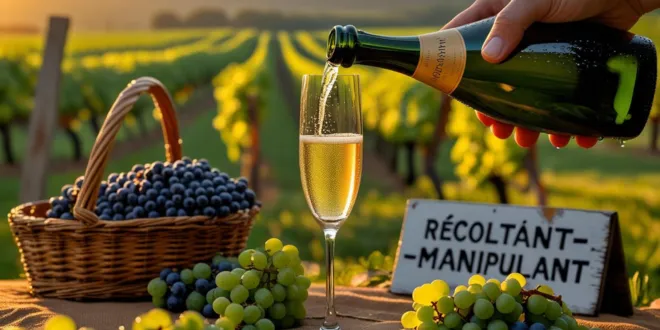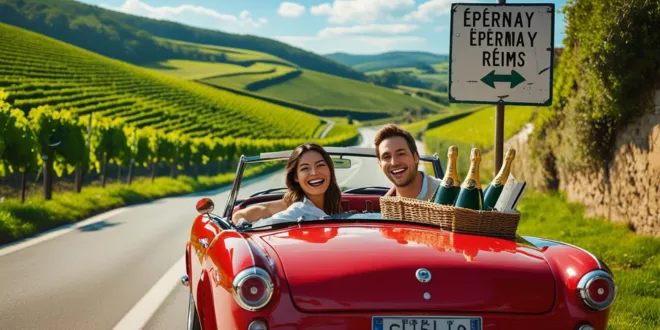The Champagne region of northeastern France is a world-renowned destination for wine lovers and curious travelers alike. Famous as the exclusive home of Champagne, this UNESCO-listed area offers a perfect blend of history, culture, and exquisite taste. Nestled between Reims and Épernay, the heart of the region lies along the scenic Champagne Wine Route, where rolling vineyards and centuries-old cellars invite exploration.
Whether you’re sipping a crisp Blanc de Blancs in a chalky crayère or discovering family-run Champagne producers to visit, every moment here is steeped in tradition. From grand maisons to boutique grower estates, there’s a style and story for every palate. This guide will walk you through the best Champagne tours, hidden gems, seasonal tips, and authentic tasting experiences. Whether you’re planning a day trip from Paris or a leisurely weekend getaway, get ready to uncork the magic of the Champagne region — one sip at a time.

Best Champagne Tours in France
Discover the finest Champagne tours across the Champagne region, where tradition meets luxury. From guided visits in Reims and Épernay to private tastings in family cellars, these experiences offer a deep dive into the world of authentic Champagne.
Whether you prefer group excursions or intimate, behind-the-scenes access, top-rated Champagne tours include transportation, expert commentary, and stops at iconic Champagne producers to visit. Follow the legendary Champagne Wine Route and explore historic houses and boutique vineyards alike. These curated journeys ensure a memorable taste of France’s most celebrated sparkling wine.
Smallest and Boutique Champagne Producers to Visit
For a truly authentic experience, explore the smallest and most boutique Champagne producers to visit along the Champagne Wine Route. Known as Récoltant-Manipulant (RM) houses, these family-run estates craft limited-batch Champagne with deep personal expression. Unlike large brands, these artisans control every step from vine to bottle, offering unique terroir-driven flavors.
Visit intimate cellars in villages like Le Mesnil-sur-Oger or Hautvillers, where passionate vintners welcome guests with warmth. These hidden gems in the Champagne region provide a rare connection to the land and tradition. Supporting them means savoring craftsmanship at its finest.
Why Visit Small Producers? Authenticity and Unique Flavors
Visiting small Champagne producers to visit offers unmatched authenticity and distinctive flavors you won’t find in mass-market bottles. These independent vintners, often working on a single plot, focus on terroir expression and sustainable practices. Each sip reflects their personal touch and deep respect for tradition.
Unlike large Champagne houses, they craft wine in limited quantities, making every tasting feel exclusive. On Champagne tours through the Champagne region, discovering these artisans along the Champagne Wine Route adds depth to your journey. You’re not just tasting wine — you’re experiencing the soul of Champagne.
Hidden Gems in the Montagne de Reims and Vallée de la Marne
Step off the beaten path and explore hidden gems across the Montagne de Reims and Vallée de la Marne, two exceptional areas of the Champagne region. While famous for Pinot Noir and Pinot Meunier, these zones are home to lesser-known Champagne producers to visit crafting expressive, small-batch wines.
Wander quiet villages like Bouzy, Verzenay, or Hautvillers — birthplace of Dom Pérignon — and discover family cellars tucked beneath historic homes. These stops on the Champagne Wine Route offer intimate tastings and personal stories. For travelers seeking authentic Champagne tours, these scenic valleys deliver unforgettable moments and rare vintages.
Supporting Local Artisans and Sustainable Practices
Choosing to visit independent Champagne producers to visit means supporting local artisans and sustainable practices across the Champagne region. Many small growers prioritize organic farming, biodiversity, and low-intervention winemaking, preserving the land for future generations.
By joining Champagne tours that highlight these values, you contribute to a more ethical wine industry. The Champagne Wine Route is increasingly dotted with eco-conscious estates producing high-quality, terroir-driven Champagne. Your visit helps sustain their legacy. Experience the difference — in flavor, in story, and in impact — one artisan bottle at a time.

Best Time of Year to Visit the Champagne Region
The ideal time to explore the Champagne region depends on your preferences, but each season offers unique charms. Spring brings blooming vines and mild weather, perfect for scenic Champagne tours. Summer features long days and lively festivals in Reims and Épernay.
Autumn is harvest season — a magical time to witness grape picking and fermentation. Winter offers cozy tastings with fewer crowds, ideal for intimate visits to Champagne producers to visit. No matter when you travel, the Champagne Wine Route reveals its beauty year-round. Plan ahead to experience the rhythm of Champagne production at its most authentic.
Spring (April–June): Blooming Vines and Mild Weather
Spring is a delightful time to visit the Champagne region, as vineyards burst into life along the Champagne Wine Route. From April to June, mild temperatures and fresh greenery create a picturesque backdrop for Champagne tours.
This season offers comfortable conditions for walking through vineyards and exploring towns like Reims and Épernay. While tastings remain the highlight, you’ll also witness early vineyard care and pruning. Fewer tourists mean more personalized attention at Champagne producers to visit. It’s an excellent window to enjoy nature’s renewal while sipping crisp, elegant Champagne in tranquil settings.
Summer (July–August): Festivals and Long Days
Summer brings energy to the Champagne region, with long daylight hours and vibrant events. July and August feature festivals, open-air concerts, and special tastings at top Champagne producers to visit. The Champagne Wine Route buzzes with visitors exploring Reims Cathedral, Épernay’s Avenue de Champagne, and lively village squares. While peak season means more crowds, it also offers rich cultural experiences.
Many Champagne tours include outdoor pairings and garden tastings. Pack light layers and book early. Sipping a glass of cool Champagne under the summer sun is a true taste of French joie de vivre.
Autumn (September–October): Harvest Season and Grape Picking
Autumn is the most exciting time in the Champagne region, as harvest season transforms the Champagne Wine Route into a hive of activity. From late September to October, vineyards come alive with grape picking, and many Champagne producers to visit open their doors to witness pressing and fermentation.
This is your chance to see how Champagne is made from the very beginning. Guided Champagne tours during this period often include behind-the-scenes access and special vintage tastings. The golden light and cool air enhance the experience. Don’t miss this immersive, sensory-rich season.
Winter (November–March): Cozy Tastings and Fewer Crowds
Winter offers a peaceful, intimate way to experience the Champagne region. With fewer tourists, Champagne tours become more personal, and tastings feel cozy and relaxed. Though vines are dormant, cellars remain active, and many Champagne producers to visit welcome guests with warm hospitality.
The Champagne Wine Route takes on a quiet charm, perfect for reflective travel. Reims and Épernay sparkle during the holiday season, with festive markets and seasonal pairings. It’s an ideal time to explore at your own pace and deepen your appreciation of Champagne’s complexity — one elegant sip at a time.

Driving Through the Champagne Wine Route
Driving through the Champagne Wine Route is one of the most rewarding ways to explore the Champagne region. This scenic route connects historic towns, rolling vineyards, and iconic Champagne producers to visit like Moët & Chandon and boutique RM houses. With your own car, you can set your pace, stop at hidden cellars, and follow personalized itineraries.
Whether starting from Reims or Épernay, the drive reveals stunning landscapes and UNESCO-listed heritage. Just remember to book tastings in advance and consider a designated driver. For flexibility and freedom, driving offers an unforgettable journey through the heart of Champagne country.
Mapping the Scenic Champagne Wine Route
The Champagne Wine Route stretches across the heart of the Champagne region, linking key towns like Reims, Épernay, Avize, and Hautvillers. Mapping your journey helps you discover both famous houses and lesser-known Champagne producers to visit.
The route passes through five main sub-regions — Montagne de Reims, Vallée de la Marne, Côte des Blancs, Côte de Sézanne, and Aube — each with unique terroir. Use official maps or apps to plan stops, tastings, and scenic viewpoints. Whether on foot, by bike, or car, following the Champagne Wine Route ensures a rich, well-rounded experience of Champagne culture and craftsmanship.
Must-Visit Vineyards Along the Route
Along the Champagne Wine Route, several vineyards stand out as must-visit destinations in the Champagne region. In Épernay, tour the Avenue de Champagne, home to legends like Moët & Chandon. In Hautvillers, visit the cellars of Dom Pérignon. Avize and Le Mesnil-sur-Oger showcase exceptional Blanc de Blancs from top Champagne producers to visit.
Don’t miss boutique growers in Ambonnay or Verzenay for powerful Pinot Noir expressions. Each vineyard offers a distinct story and tasting experience. Whether you’re on a guided tour or self-guided journey, these stops are essential for any Champagne tours itinerary.
Scenic Drives: Montagne de Reims, Côte des Blancs, Vallée de la Marne
For breathtaking views, explore the scenic drives through Montagne de Reims, Côte des Blancs, and Vallée de la Marne — the crown jewels of the Champagne region. The Montagne de Reims offers forest-framed vineyards perfect for Pinot Noir. Côte des Blancs, with its chalky slopes, produces elegant Chardonnay-based Champagne.
Vallée de la Marne follows the river, home to vibrant Pinot Meunier. These routes are key sections of the Champagne Wine Route, ideal for Champagne tours by car. Each drive reveals unique landscapes and access to renowned and boutique Champagne producers to visit.
Eco-Friendly and Organic Champagne Tours
Eco-friendly and organic Champagne tours are rising in popularity across the Champagne region. More travelers seek sustainable experiences that support Champagne producers to visit using organic, biodynamic, or low-impact methods.
These tours often include visits to vineyards certified by Ecocert or Demeter, where nature thrives alongside quality Champagne production. Following the Champagne Wine Route, you’ll find estates reducing chemicals, restoring biodiversity, and embracing regenerative farming. Choosing green Champagne tours not only benefits the environment but also introduces you to purer, more expressive wines rooted in respect for the land.
What Does “Organic Champagne” Mean? Certification and Standards
“Organic Champagne” refers to wine made from grapes grown without synthetic pesticides or fertilizers, certified by official bodies like Ecocert or the EU Organic logo. In the Champagne region, organic producers follow strict standards during both farming and vinification. Many also pursue biodynamic practices for deeper harmony with nature.
When joining Champagne tours, look for labels such as “Vin Biologique” or “Demeter.” These certifications ensure authenticity. Visiting Champagne producers to visit with organic credentials offers insight into sustainable innovation. The result? Cleaner, terroir-driven Champagne that reflects both quality and conscience along the Champagne Wine Route.
Biodynamic and Sustainable Vineyards to Visit
Explore biodynamic and sustainable vineyards that are redefining excellence in the Champagne region. These Champagne producers to visit follow holistic farming methods, aligning vineyard work with lunar cycles and natural ecosystems. Estates like Larmandier-Bernier and Pierre Péters lead the movement, crafting expressive, low-intervention Champagne.
Their commitment shines in every bottle. On Champagne tours, you’ll learn about composting, biodiversity, and soil health — all vital to sustainable winemaking. The Champagne Wine Route now highlights these eco-conscious pioneers. Tasting their wines offers a purer connection to the land and a glimpse into the future of Champagne.
Tours Focused on Environmental Stewardship
More Champagne tours now emphasize environmental stewardship, reflecting a growing awareness in the Champagne region. These experiences connect visitors with Champagne producers to visit who prioritize eco-innovation — from solar-powered cellars to zero-waste packaging.
Guides explain how sustainable practices protect soil, water, and local communities. Some tours even include vineyard walks focused on biodiversity and climate resilience. By choosing these responsible Champagne tours, travelers support a greener future. The Champagne Wine Route is evolving, blending luxury with ethics. It’s a chance to enjoy world-class Champagne while honoring the planet.
How Eco-Tourism is Shaping the Champagne Industry
Eco-tourism is transforming the Champagne industry, encouraging producers across the Champagne region to adopt greener practices. As travelers seek meaningful, sustainable experiences, Champagne tours increasingly highlight organic farming, carbon reduction, and community engagement.
The Champagne Wine Route now features eco-certified estates and green-certified tour operators. This shift empowers small Champagne producers to visit who value long-term land health over mass production. Consumers reward authenticity with loyalty. The result? A more responsible, transparent Champagne culture. Eco-tourism isn’t just a trend — it’s shaping the future of how we experience and enjoy true Champagne.

Tips for First-Time Visitors to the Champagne Region
First-time visitors to the Champagne region should plan ahead for the best experience. Book Champagne tours and tastings in advance, especially at popular Champagne producers to visit. Reims and Épernay are ideal bases. Dress smart-casual for vineyard visits.
Learn basic terms like Brut, Rosé, and Blanc de Blancs to enhance your tasting. Most houses don’t require tipping, but gratitude is appreciated. Limit to 2–3 tastings per day to savor each one. Follow the Champagne Wine Route at a relaxed pace. And most importantly — drink responsibly and enjoy the magic of authentic Champagne.
Conclusion
Exploring the Champagne region is more than a wine tasting — it’s a journey through history, terroir, and craftsmanship. From grand maisons to intimate Champagne producers to visit, every stop on the Champagne Wine Route tells a story of passion and precision. Whether you’re sipping vintage Champagne in a centuries-old cellar in Reims or discovering organic growers in the Côte des Blancs, the region offers unforgettable experiences. The best Champagne tours blend education, scenery, and flavor, allowing you to connect deeply with this UNESCO-recognized landscape.
Seasonal rhythms shape the visit — spring’s blossoms, summer’s festivals, autumn’s harvest, and winter’s quiet charm. Driving the Champagne Wine Route gives freedom, while eco-friendly tours support sustainable practices reshaping the industry. For first-time visitors, preparation enhances enjoyment: book tastings early, explore beyond famous names, and embrace the art of slow travel.
By choosing boutique producers and green-certified Champagne tours, you contribute to a more authentic and responsible wine culture. The Champagne region isn’t just about luxury — it’s about legacy, land, and the people who craft one of the world’s most beloved drinks. So uncork your curiosity, follow the vineyards, and let the spirit of Champagne guide your journey — one exquisite sip at a time.
Frequently Asked Questions
1.What is the best way to experience Champagne tours in the region?
Join guided or self-driven Champagne tours along the Champagne Wine Route. Visit both renowned houses and small Champagne producers to visit for variety. Book tastings in advance, especially in Reims and Épernay. Include stops in Côte des Blancs and Montagne de Reims for diverse terroirs. Always savor responsibly.
2.Where should I go on the Champagne Wine Route?
Start in Reims and Épernay, then explore Avize, Le Mesnil-sur-Oger, and Hautvillers. These towns are key stops on the Champagne Wine Route and home to top Champagne producers to visit. Each offers unique cellars, scenic views, and exceptional Champagne tastings rooted in tradition and terroir.
3.Which Champagne producers to visit are eco-friendly?
Visit biodynamic and organic Champagne producers to visit like Larmandier-Bernier, Pierre Péters, and Agrapart. These estates in the Champagne region follow sustainable farming, reduce chemicals, and prioritize biodiversity. Their Champagne reflects purity and respect for the land, ideal for eco-conscious Champagne tours.
4.When is the ideal time to visit the Champagne region?
Autumn during harvest offers a lively experience, while spring brings mild weather and blooming vines. Summer has festivals; winter offers cozy, quiet tastings. Any season works for Champagne tours, but booking ahead ensures access to top Champagne producers to visit along the Champagne Wine Route.
5.Do I need to book Champagne tastings in advance?
Yes, most Champagne producers to visit require reservations, especially boutique houses. Popular Champagne tours in Reims and Épernay also fill quickly. Booking ensures entry, personalized service, and avoids disappointment. Always confirm times and cancellation policies when planning your Champagne region itinerary.
6.Can I drive the Champagne Wine Route myself?
Absolutely. Driving gives flexibility to explore the Champagne region at your pace. Follow the Champagne Wine Route signs, visit hidden vineyards, and stop at charming villages. Just arrange designated drivers or tours for tastings. Renting a car from Reims or Épernay is convenient.
7.What makes small Champagne producers special?
Small Champagne producers to visit offer authentic, handcrafted wines with unique terroir expression. Often family-run, they focus on quality over quantity. Their intimate tastings provide personal stories and rare vintages. Choosing them supports local artisans and enriches your Champagne tours experience.
8.Are there organic Champagne tours available?
Yes, eco-friendly Champagne tours are growing in the Champagne region. These focus on organic and biodynamic Champagne producers to visit, emphasizing sustainability. You’ll learn about green practices while tasting pure, expressive Champagne. Look for certified estates on the Champagne Wine Route.
9.What should I know before my first Champagne tour?
Book tastings early, dress smart-casual, and limit to 2–3 visits per day. Learn basic terms like Brut or Blanc de Blancs. Most tastings don’t require tipping. Stay hydrated. Whether on a group tour or self-guided, respect vineyard rules during your Champagne region visit.
How does tourism support Champagne producers?
Tourism helps small Champagne producers to visit thrive by promoting direct sales and cultural exchange. When you join Champagne tours, you support local jobs, heritage, and sustainable farming. Your visit encourages preservation of traditions across the Champagne region and strengthens the Champagne Wine Route economy.
